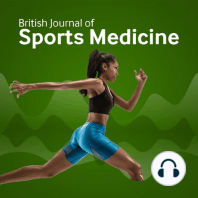14 min listen
Stop swimming upstream - a new model for swimmer’s shoulder
FromBJSM Podcast
ratings:
Length:
22 minutes
Released:
Jun 16, 2017
Format:
Podcast episode
Description
Struggling with swimmers and their shoulders? It’s something we clinicians struggle with, and have been for a long time. Today we’re gonna take this head on, how we can move the model from external impingement to anterior superior internal impingement (ASII).
We are joined on this BJSM podcast with Andrew Delbridge and Craig Boetcher from Australia. Craig completed his PhD through Sydney University examining shoulder EMG back in 2010. He’s been the physiotherapist for the Australian swim team for the last 8 years, and offers a unique perspective to this issue, having been an elite swimmer himself.
Craig is currently supervising Kylie Holt who is completing her PhD on Shoulder pain and pathology in elite swimmers. Kylie is a senior sport physio at the Australian institute of sport, and has been looking after the swimming programme since 2009.
Our second guest is Andrew Delbridge, who has been working with Craig at Regent St Physiotherapy for the last 17 years. Andrew has been working in elite sport with throwing athletes, and has found a fresh way of looking at the swimmer’s shoulder.
1:25 What is swimmer’s shoulder? External impingement model from the 70s outdated
2:00 Difference between primary and secondary impingement
3:40 We’ve got swimmer’s shoulder wrong. Andrew explains some of the reasons.
5:10 Spoiler alert - you guessed it, its internal impingement.
ASII- Anterior superior internal impingement
6:00 Clinical background that initially drove the reason for the new ASII approach
8:20 What can baseball teach us about swimming? The loads don’t make sense!
Buhrkart influenced throwing shoulder which led to applying that in swimmers
9:25 3 questions to understand the swimmer’s shoulder:
1) What is the unique position for swimmers in their stroke,
2) what is the anatomical relations in that position,
3) can we reconcile pathology we see?
10:00 Unique position for the demands of swimming - elevation and internal rotation while in large amount of elevation
10:30 Literature also looks at this position (classic Hawkins & Kennedy) investigating the anatomy in this position.
11:30 Position vs load - which causes the pain? It’s mix of tensile and compressive load
12:00 ASSI explained
Swimmers are super overhead workers
13:15 The data are building, but it’s still early. 60 swimmers included in large MRI study
15:00 Does this only apply to elite swimmers? No.
16:25 Key differences in ASII model:
Internal not external, tendinopathy (anterior or posterior).
Mix loading (compressive load in ASII) which might apply to the whole cuff,
Broad term of swimmer’s shoulder to vague, sub-classification needed to differentiate treatment
18:15 3 practical tips for the clinician:
1) Shift in thinking, apply your tendinopathy theory
2) Use dynamometry to assess cuff health
3) Monitor training load.
Full text now available here: https://goo.gl/rQ4EMF
We are joined on this BJSM podcast with Andrew Delbridge and Craig Boetcher from Australia. Craig completed his PhD through Sydney University examining shoulder EMG back in 2010. He’s been the physiotherapist for the Australian swim team for the last 8 years, and offers a unique perspective to this issue, having been an elite swimmer himself.
Craig is currently supervising Kylie Holt who is completing her PhD on Shoulder pain and pathology in elite swimmers. Kylie is a senior sport physio at the Australian institute of sport, and has been looking after the swimming programme since 2009.
Our second guest is Andrew Delbridge, who has been working with Craig at Regent St Physiotherapy for the last 17 years. Andrew has been working in elite sport with throwing athletes, and has found a fresh way of looking at the swimmer’s shoulder.
1:25 What is swimmer’s shoulder? External impingement model from the 70s outdated
2:00 Difference between primary and secondary impingement
3:40 We’ve got swimmer’s shoulder wrong. Andrew explains some of the reasons.
5:10 Spoiler alert - you guessed it, its internal impingement.
ASII- Anterior superior internal impingement
6:00 Clinical background that initially drove the reason for the new ASII approach
8:20 What can baseball teach us about swimming? The loads don’t make sense!
Buhrkart influenced throwing shoulder which led to applying that in swimmers
9:25 3 questions to understand the swimmer’s shoulder:
1) What is the unique position for swimmers in their stroke,
2) what is the anatomical relations in that position,
3) can we reconcile pathology we see?
10:00 Unique position for the demands of swimming - elevation and internal rotation while in large amount of elevation
10:30 Literature also looks at this position (classic Hawkins & Kennedy) investigating the anatomy in this position.
11:30 Position vs load - which causes the pain? It’s mix of tensile and compressive load
12:00 ASSI explained
Swimmers are super overhead workers
13:15 The data are building, but it’s still early. 60 swimmers included in large MRI study
15:00 Does this only apply to elite swimmers? No.
16:25 Key differences in ASII model:
Internal not external, tendinopathy (anterior or posterior).
Mix loading (compressive load in ASII) which might apply to the whole cuff,
Broad term of swimmer’s shoulder to vague, sub-classification needed to differentiate treatment
18:15 3 practical tips for the clinician:
1) Shift in thinking, apply your tendinopathy theory
2) Use dynamometry to assess cuff health
3) Monitor training load.
Full text now available here: https://goo.gl/rQ4EMF
Released:
Jun 16, 2017
Format:
Podcast episode
Titles in the series (100)
Professor Roald Bahr - IOC World Conference on Prevention of Injury & Illness in sport 2014: With Professor Roald Bahr, chairman of the Scientific Committee and member of the IOC Medical Commission.Are you planning your conference contribution or attendance for 2014? Those who attended the first 3 World Conferences on Injury & Illness Preven... by BJSM Podcast
